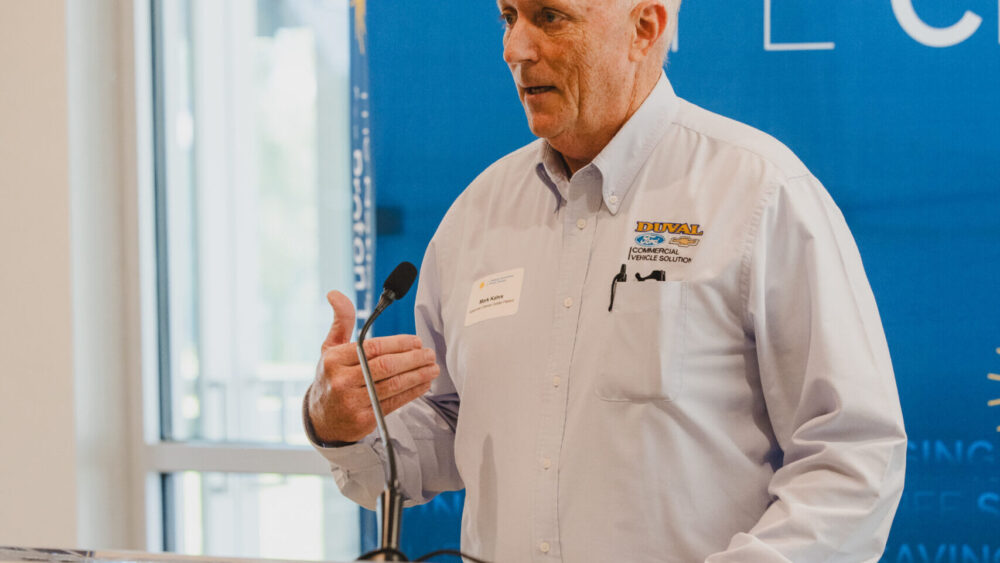April is Head and Neck Cancer Awareness Month, a time to spotlight stories of resilience, healing, and hope. One such story belongs to Mark Kahrs, who was diagnosed with head and neck cancer just over two years ago. Today, he’s doing well, sharing his experience, and reminding others that a cancer diagnosis is not a death sentence.
Mark’s journey began shortly after his son’s wedding when he noticed a lump on the right side of his neck. After multiple doctor visits, rounds of antibiotics, and inconclusive scans, he finally received a biopsy. The results came by phone: it was cancer.
His first thought was immediate and raw: “Am I going to die?”
That question, filled with fear and uncertainty, is one that countless people face upon diagnosis. But two years later, Mark is thriving. He’s healthy, active, and eager to share his story with others who may be standing where he once stood.
Starting Treatment and Finding Focus
When Mark was first diagnosed, he was referred to a hospital that did not offer proton therapy. After learning more about his options, he found another center that did and was scheduled for treatment almost immediately. That choice became pivotal in his recovery.
“Looking back,” Mark says, “that turned out to be a blessing in disguise.”
He began proton therapy quickly. There was barely time to process what was happening. He was being scanned, fitted for his treatment mask, and scheduled for daily sessions. The process was intense, but it brought structure. Mark describes the care he received at Ackerman Cancer Center as deeply compassionate and unwaveringly supportive.
“Everyone there was incredible—from the front desk to the nursing team, Dr. Ackerman, and even the cookie lady,” he recalls. “They gave me hope. I started my day with them before heading to work, and their positivity and kindness kept me going.”
The treatment mask, once a symbol of fear, became a reminder of perseverance. Mark kept it after he completed therapy—not as a memento of suffering, but as a marker of progress. “It kept me focused,” he says. “I didn’t want to be there, but it kept me steady and moving forward.”
Staying Active Physically and Mentally
Throughout his treatment, Mark made the decision to continue working. He describes it as an anchor during a chaotic time.
“Going to work kept my sanity,” he says. “If I had just sat at home and focused on the diagnosis, I don’t know where I’d be. Work gave me something else to focus on.”
That focus helped him push through treatment with a strong mindset, even on the hardest days.
The Benefits of Proton Therapy
Proton therapy offered Mark a path forward with fewer side effects, allowing him to maintain his daily routines and responsibilities. He didn’t need a feeding tube, wasn’t hospitalized, and was able to continue speaking, eating, and working throughout treatment.
Unlike traditional radiation, which can damage surrounding healthy tissue, proton therapy’s precision limits exposure to critical areas of the head and neck. For many patients, this can significantly reduce side effects and complications. The treatment becomes not only more tolerable, but also more compatible with daily life.
“Proton therapy made it possible for me to keep going,” Mark says. “I didn’t feel like I had to stop everything else.”
Speaking Out and Giving Back
In 2024, Mark shared his story during an event honoring Congressman John Rutherford, where he spoke about the importance of expanding access to proton therapy. While not every hospital offers it, geographic access to this treatment can make a life-changing difference for patients—especially when time is critical.
“Had I not had another option nearby, I don’t know how things would’ve gone,” he said. “It was important to start quickly and to have access to the right treatment.”
He also emphasized the broader value of proton therapy, not just in clinical outcomes, but in preserving a patient’s ability to continue living a full life during and after treatment.
Two Years Later: Cancer Isn’t a Death Sentence
Today, Mark’s checkups and bloodwork remain positive. He feels good, speaks clearly, and continues to stay involved in his work and community. He says the experience has changed how he connects with others, particularly those who are newly diagnosed.
“When I was diagnosed, I thought, ‘Am I going to die?’ And now, I can tell people: Cancer is not a death sentence. It’s hard. But you can get through it.”
He often reaches out to others going through a difficult time, offering a message of reassurance and solidarity. “Even just a message—letting them know they’re not alone—can make a big difference.”
Mark also gives credit to his wife, Kathy, who was by his side every step of the way. “Caregivers don’t always get the recognition they deserve,” he said. “She advocated for me, kept everything organized, and kept me grounded.”
Looking Ahead
As research into proton therapy continues, more patients like Mark may benefit from its ability to treat cancer while minimizing damage to healthy tissue. And thanks to patient voices like his, more people are learning that advanced options exist and that quality of life during treatment matters.
During Head and Neck Cancer Awareness Month, Mark’s story is a powerful reminder of what’s possible—not just surviving cancer, but living well after it.






